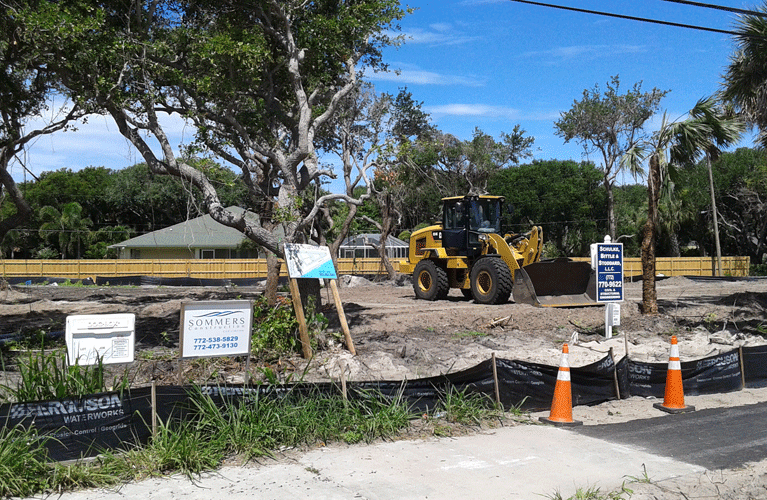
Work has begun on a new six-home subdivision on the west side of A1A north of Route 510 that is expected to alter traffic patterns in the quiet Summerplace neighborhood.
People living near the new subdivision, tentatively called Sommers Place, fear cut-through traffic on an extended road will be a problem, but county planners say that’s unlikely.
Sommers Development Group bought the triangular subdivision site half a mile north of 510 last year, paying $350,000 for two acres of land. After getting a preliminary site plan approved by the county, the company began site work in late May, clearing underbrush, grading and marking mature trees for preservation.
Project manager Beau Sommers said the company expects to have subdivision infrastructure in place by fall with six finished lots ready for construction.
“September, we should be ready to roll,” he said.
Lots will average about 8,500 square feet, slightly less than a quarter of an acre, and be sold for approximately $200,000 a lot. The lots will accommodate single-story homes up to 3,400 square feet and two-story homes up to 5,100 square feet, according to Stan Boling, county director of community development. By county code, single-story homes can cover a maximum 40 percent of the lot while two-story homes can occupy 30 percent.
While oceanfront homes a stone’s throw away on the east side of A1A go for millions, older for-sale houses on the streets adjacent to the new subdivision are listed in a range between $385,000 and $532,000, with per-square-foot costs between about $210 and $290. New construction would be worth more. Even at just $300 per square foot, a brand-new 5,100-square-foot house would theoretically be valued at more than $1.5 million, while a 3,400-square-foot single-story home could be worth $1,020,000.
With that kind of potential value, the lot price seems reasonable, but Sommers is not sure who his buyer or buyers will be. He said he is fielding calls from builders active in Indian River County who are interested in acquiring all the finished lots, but he said lots also could be sold individually to builders or owner/users. At the same time, Sommers Development Group, a general contractor, could wind up building houses in the subdivision, Sommers said.
Sommers does not have an overall theme or building style envisioned for the subdivision. Instead of a cohesive architectural style, he expects each home will reflect the preferences and style of its owner or builder.
As the project gets underway, one of the first steps will be to extend Magnolia Lane, now a dead-end road, through the property and connect it to A1A. Three of the new homes will be on the south side of the short Magnolia extension while the other three will be on the north side.
Neighbors fear increased traffic from drivers who opt to cut through on Magnolia to bypass the A1A/Route 510 intersection.
“I’m on the front line of it,” resident Julie Love, whose home is near the subdivision site, told Vero Beach 32963. She calls the decision to make Magnolia a through-road instead of leaving it a dead-end “most upsetting.”
Boling said the developer had several options when laying out the subdivision. They included extending Magnolia to A1A or constructing a private road off A1A that either dead-ended at Magnolia or ended with a cul-de-sac. The cul-de-sac option likely would have meant the loss of a homesite.
“They opted for what code allows,” Boling said of the Sommers Development Group.
“We along with Indian River County Community Development decided bringing Magnolia Lane through to A1A was the best option and access for all parties,” Beau Sommers said.
Boling said the county did not conduct a study of how the subdivision would affect local traffic because such a study was not warranted for such a small project. Instead, he offered anecdotal evidence that existing sideroads off A1A, such as Coco Plum Lane, don’t carry much cut-through traffic. If anything, Boling noted, Summerplace residents might use the Magnolia extension to get to A1A faster.



